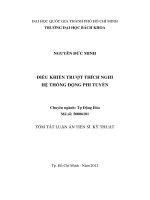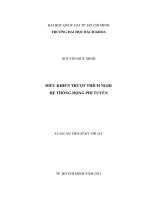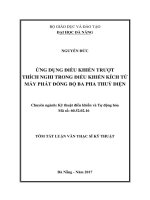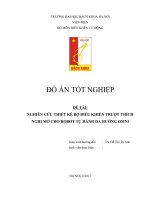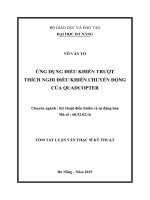9Điều khiển trượt thích nghi phân ly
Bạn đang xem bản rút gọn của tài liệu. Xem và tải ngay bản đầy đủ của tài liệu tại đây (190.17 KB, 6 trang )
JOURNAL OF S( IFNCE & TEC HNOUOCJY * No. 79B - 2010
DECOUPLED ADAPIIVE SLIDINCJ MODE CONTROL
DIED KHIl'.N IRlK.yi' fllicil NGHI PHAN LY
i\giiyen
Due Minh, Nguyen Due Thanh, Duonfj Hoai
llo ('hi Minh University
ofTcclinology
Nghia
ABSTRAC T
This paper proposes a controller for a class of nonlinear unknown dynamic systems. First,
based on the Sliding l\/lode Control (SMC) theory and neural network technique we introduce a new
Adaptive Sliding Mode Control (ASMC) for SI SO systems The purpose is to find the optimal control
rule, which can overcome the chattering phenomenon and help the system to resist the disturbance
without knowing its parameters. Second, we present a Decoupled Adaptive Sliding Mode Control
(DASMC) to develop the ASMC technique for the 4"' order multivariable system. Finally, we apply
the above-mentioned theory to handle the two dimensional inverted pendulum, keeping it balanced in
upright position and moving along reference trajectories on the horizontal plan. The simulation results
confirm the effectiveness of the proposed controller
TOM TAT
Bdi bdo ndy gidi thieu mpt phwgng phdp diiu khiin cho Idp cdc he thdng phi tuyin khdng ro
md hinh ddng hoc. Diu tien, diiu khiin ASMC dwgc gidi thieu di/a trdn ly thuyit diiu khiin trwgt va ky
thudt mang no- rdn. dp dung de diiu khiin cdc hd thing SISO. Bd diiu khiin ASMC khdng nhirng
khic phuc dwgc hien twgng chattering md cdn cd kha ndng khdng nhieu. Sau dd. bdi bdo gidi thieu
diiu khiin phdn ly biin sd di cd thi phat triin ky thudt diiu khiin ASMC cho cdc he thing da biin
bac bdn. Cudi cimg, ly thuyit diiu khiin trwgt thich nghi ndi tren dwgc dp dung di diiu khiin he thing
xe con lie ngwgc hai chiiu, giw dwgc thang bdng ngwgc, bdm theo mdt quy dao mong mudn cho
trwdc tren mat phing ngang. Mdt sd kit qud md phdng da cho thiy tiim ndng ciia bd diiu khiin dwgc
di nghi.
controller,
is developed to compute the
corrective and equivalent controls, without the
!"'.:!1 a\aikibilit> VM
. " the model parameters.
Furthermore, adaptive neural sliding mode
control is a continuous control, so there is no
more chattering phenomenon on the input
control.
I. INTRODUCTION
Variable Structure Control (VSC) with
sliding mode, or SMC is a nonlinear control
strategy that is well known for its robust
characteristic. However, conventional sliding
mode control has two disadvantages, which arc
1) the chattering (phenomenon), and 2) the
obligation to delimit in advance the model
parameters. To solve this problem, in recent
years, the neural or fu//y-neural network has
been proposed to estimate the unknown motlel
functions [1] -[3], or to compensate the
uncertain components of the plant 14]-[5].
However, these training algorithms for neural
network are complicated and although the
chattering phenomenon has been reduced, this
phenomenon still exists on the control signal.
B> combining the decoupled control
theorv and the .ASMC technique, this paper also
presents a decoupled ASMC to develop the
ASMC for a class of 4 " order multivariable
sv stems, which is quite usual in practice, like
the cart inverted pendulum.
Ihe rest of this paper is organized as
follows. Section 2 presents the traditional
sliding mode control. Section 3 introduces the
structure and update rule for the DASMC.
Section 4 provides simulation results. Finally,
the conclusion is given in Section 5.
In this paper, a neural network based
Adaptive Sliding Mode Controller (ASMC) is
proposed. Based on the sliding mode control
theory, a simple updated rule for multilayer
neural network, which is used as a direct
II. SILIDING MODE CONTROL
2.1 Control problem
70
JOURNAL OF SCIENCE & TECHNOLOGY * No. 79B - 2010
Consider a nonlinear system
5{x) =
y'"'=f{x)
+ g{x).u + d
(c„.„e"'-"+.... +c,e
g(x)
+ cf'+ f{x)-r + d)\
(2.1)
u is the control input;
Let
X = {y\ v>'f""'^ ]' is the state vector;
with p =rf(,v)+ /?jj, /3,>0.
y is the output;
/(^)'
functions ;
^(^)
unknown
III.
ADAPTIVE
CONTROL
It follows that
u^ =f„ =N{e,w)
(2.2)
5 = e'"-" +c,„_,)e"'"'' +.... + c.e + c,e
(3.1)
where e is the input vector, w is the weight
vector of the network. Based on the sliding
mode control theory, the weights should be
updated online so that 5- > 0 as / - > 00.
(2.3)
The coefficients, c,....C(„_,p are chosen
the
polynomial
C-,/^-l-C] is Hurwitz. This
From (2.3) it can be seen that s->Q as
/->oo if
condition ensures that if 5 = 0 then e - > 0 as
r->oo
(3.2)
V = s.s
vi/<0
du dw
From (2.3) we have:
or
The control problem is to find the control
signal u, to bring the state trajectory of the
subsystem towards the sliding surface and
remain on it, regardless of external
disturbances.
(3.3)
5.
s= [(f{x)+c^„_,/"-'' +....+c,e+c,e+ ^^ ^^
+c/-/-""+g(x)j/)k7/+5(0)
2.2 Sliding Mode Control
From (2.2) and (2.3) we have
du
= c^„_,/''-''+....+cfe + c,e + f{x)+
= lg(x).dt
A h{x)>0
fO(5"l
- u.satl — . —
V = -s'
(2.5)
Ave :
2
We have
( s V d u Y
.^
- /.i.sal\ — . —
{<^)\dw)
( sVduY
Lt.sat]— . —
//
.
:
• n
(/
5.5 > 0
„
^
S.S < 0 and
1-1^ 1 I I
\s\ < —\s\
rf
..
. „
, |.| 1,1
;/ s.s<\j and \s\>—\s\
(3.6)
F=5i=5.(C(^,/'"''+...qe+qe+/(x)
+J-/-"")+g(x)52/
(3.5)
The proposed update rule is as follows
(2-4)
+ ^-r'"'+g(jc).M
Let
MODE
Consider a q layer feed forward neural
network which is used as an adaptive controller,
vve have:
The control problem is to find the control
u so that the output y tracks the desired output
r
e=y- r
SLIDING
3.1 Adaptive neural sliding mode update rule
let r be the desired output.
such
that
A"~ +c,^_^sX'~' +
(2.8)
I • < 0 and .V- > 0 as / - > oo
are bounded
d is bounded disturbance;
Define
u = -f3..sign{.s)
(2.7)
(2.6)
Where
1
sat{x) = - - 1
X
where
71
,
,
,
x>\
x<-\
-1 < X <1
(3.7)
JOURNAL OF S ( l F N { L & T E C H N O l A ) l , Y * INo. 79B - 2010
IV. ASMC SIMULATION
and r^ and O are positive constants.
3.2 Decoupled
Controller
Adaptive
Sliding
4.1 Simulated system
Mode
Consider the Two Dimensional Inverted
Pendulum (21) Inverted Pendulum) shown in
fig.l. Let / be the deviation angle of the
inverted pendulum from the z - axis : a y9 be
the projections of y on the x- / and y - z planes
(fig.2); X and > be the cooidinates of the
position of the car in x y plane; u, and u^ be
•fhis section prcscnls the decoupled
ASMC so that the ASMC can be applied for a
class of 4"' order multivariable systems.
Consider the 4''' order svslem
.V, = / | ( v ) + .t,'|(.v).»-!-(/,
•V, =
the forces applied to the car along x and y axis,
respectively.
(-3.9)
V,
z
.V, = / , ( . V ) + , V , ' ; ( V ) . » + C / ,
V, = .V, ;
V
= .V.
^ V-o: P M M o c o r
\
Define the error signal
(3.10)
and
.V, = c,c?, + t',; .v-, = c,e, -\-c\
/^^
\
(3.11)
-VM: P M M o c o r
\
c,, C-, are positive constants.
s^ and s^ are the two sliding surfaces
that should be led to zero, but here vve have
only one control signal to handle. To solve this
problem, this paper applies the method that Lo
and Kuo have introduced in [6], according to
which, 5, has been changed into s. So that .v
includes the infonnation of 5, as well as .ss , as
the following
.v = c,(e,-r) + e,
z = sat{sJ(D^).z„
Fig. I Two Dimensional Inverted Pendulum
In realitv. the real car pendulum has two
force control input signals u,. M, , and four
measurable outputs a fi, x, v
(3.12)
0 < r „ <1
O . is positive constant;
In [6], if V
. = 0, 5, and 5, will tend to
zero too. In that case, 0, 0. e^ and e^ will
also tend to zero, which is also the control
purpose.
Fig. 2 Coordinate presentation.
A controller like the ASMC described in
section 3.1 can be used to handle ,v to come to
zero as well. In this case, the controller is called
the decoupled ASMC.
The control problem is to design an
ASMC for the above 2D inverted pendulum, to
keep it in upright position and move along
desired trajectories on x-y plan defined by Xj,
i
72
JOURNAL OF SCIENCE & TECHNOLOGY * No. 79B - 2010
Using the method of Lagrangian
equations, the dynamic equations of 2D
inverted pendulum can be presented
tan(a) + tan(/7) 1
^ sin(<'^) + cos(^>') ;
X, -y = arctan
(4.8)
(4.9)
c. =c\..cos(^)-f-c',..sin(6')
(,'\/ + m)(j + — ml.y.C:OS{Y) — m.l.y^ sin(x) + c,„,.v = u^
\
\
'...
~
...
.
\
,
(4.10)
c\ ^- c\ .sin(^) - c, .cos(6')
„
— m.l.q + — m.l.Y + c„, .y — m.g.l. = 0
2
3
'•'
2
Define c-, =L',, e^ =c^,i\nd
{m + .\l)h + c\i.h = III,
+ .V, ;
.V, = C | . . V ,
.Vj -
c^e. + ^'4 ;
(4.1)
.V, = c ' , c % + c ; ,
where / is the length of the pendulum; ni is the
mass of the pendulum; M is the mass of the
car; c^, c„, are friction coefficient, and
"„ =u^.cos{e)-u^.sm{0)
(4.7) can be decomposed into two subsystems,
A and B. Subsvstem A consists of the state
variables v, . v., c,, t-,, and the sliding
surfaces ,v, and .v,. Subsystem B consist of
state variables c'5, c^, and the sliding surface .v,
So. based on the ASMC theory, we design the
ASMC controller, which has two subcontrollers (fig 3). The first is the Decoupled
ASMC, which receives x,, x., t?,, e^ as input
signals, and generates the u^ signal to handle
s^, 5, simultaneously equal to zero. The second
is the ASMC, which receives e^, e^ as input
signals, and generates the z/^ signal to handle
5, to zero.
^^^^
u^ -u^.%\n{9) + u^.cos{6)
0 is the deviation angle of the projection
of the pendulum on to x - > plan and x - axis.
We have
a = arctan(tan(x).sin(^))
(4.3)
y9 = arctan (tan (x).cos(^))
(4.4)
x = 9.sin(^) + /?.cos(6')
(4.5)
y^-q.cos{9)
(4.6)
+ h.sm{0)
In this simulation, the parameters of the
inverted pendulum are M = 0.5 kg, m = 0.3 kg,
/ = 0.3m, c,, =0.01,c„ =0.01, g = 9.Sm/s-
a
<
r/ji''("im7'(i^iL'iJnV,//'ri(/c'i7
nun r>\o ^ub - .M ^leii
— .X]
X, =f{x)
IS.WC
Siihcomrnllpf
In general, the dynamic equations of 2D
inverted pendulum can be represented as
X-,
-D,.,„„,.U;I
I
SuhLoniiotlcr
P,
Comhinalion
!
]
\tl\fO
adaptive
Sliding
Mode ( ontndler
1
1
Di'urihuted
conlml
stgmils t onifom-ni
Fig 3. ASMC for 2D inverted pendulum
+ g,ix)M
The following formulas have been used
to compute the real output control signals
(4.7)
X, = / , ( j f ) + g2(^)-i',
Xe=AM
where
+ S3M^'i,
x = [x^ x^ x^ x^ x,
= [y
y
q q
xj'
n, =M,,.sin(0) + »,,.cos(^)
(4.9)
H, =-;/,,. cos(^) + »,.sin(^)
(4.10)
Some parameters of the sliding surfaces
and the sub-controllers have been chosen as
c, = 4 ; c, =C3=l; ^ = 10; ^ = 0.5; r, =4.7,
where r = 0.01 is the sampling time; the neural
network using in ASMC is the 12 neuron Single
Hidden Layer with four inputs, one output, and
the learning rate /^ = 0.01;
h h]
g , f^ (/ = 1,3) are nonlinear functions.
4.2 Controller design
Define e = x - x ^ ; e^. = y - > ' j • From
(3.3), (3.4), (3.5) and (3.6) we have
73
lOl KNAI
4.3 Simiiialioii
I I I N I U I h , i i k e'.
Ii,i\e
|u-i ll ll i i u d
miller
,ii i i p l il i i i h " ,
i(N)
|H-,ik l o |K-,ik ,il I h e I. iMiliul i i i | i i i | ' ,
oulpillx
V ,,
,lie
(r
e o s ( D.I / )
/)'
0 ,
\ _,
.llld
-^..J-^
I s"
l>
W)"
I'iyf>
(I
\ 1 Iriijit
/>fi nIII rr\/iri
liisl li.iiiiiii!' p e i i i u l
hi.'eii
JiiiiMij
'Jiuw
loi iiieil
IIK'
lliiid
/'ITKHI.
ileMied
Mll( 0 I / )
;(())
I h e K-Mihx ll I'll! Ill'
Ii,i\ e
troinin','
\ pi,in
I lie i n i l i . i l •.l.iles ,ire
1(0)
Mie
2010
Si I- i h e ( l e . i i e d l i ; i | e ^ h H v i il i h e
e,ii IN llie e n e l e Ii , K k m i x
\(ll)
* N o . 7'>|{
/••/;,.' 1" Third
usiills
I h e Miiiiil.ilH 111 I i M i l l ' .
e\li.Mii.il
O l S< II N ( i:>Si r i : ( 1 I N K ) ! , ( ) ( , \
l
ol lir\l
mill
lliird
IrLiiiiu,
11\ riy.
I ,111(1 ^,1 d m i n : ' t h e
ih,il l l i r ( i p l i i i M J l u l l . ' ,
Niui
11 o m
11,1111111'.'
11"
peihul
• ;iiul
iliL'
\f^-
()|i
'.vsk'in
p e l loi lu.iiKi.' i\ 1,11 lielU'i
fig,7
svsicni
.Iiul
shows
llie
llic
hi.'li:i\iiii
pi,'i tl 11 iii.iiu e
ul
111
llii.' t n i i l n i l
•r
llie
SII'IKI!
u i u l e i l l i e sii iMi'j i l i s l u i h . i i i e e .
i^-^i^-^^t.^^.
'^jff^
rv^ ^ N/v
i'A'.ViVi'iV ãô I " ã ' ã I ãô'<'ã nôằ (
I'
11 I I I K l I I
I IKIIII II
VCfJ
I •lLJiJi•j|^i•l•.*^.•>•^— '
/•/.I,'.
ihc
•iSWViW
Ihc •^iiniiliilinii under ihc Viiriiition (f
ili\lurl\nh\'.
ll»LLJLL.A,i,l.|,l|>rti»
\ . ( O N C Ll S I O N
'.,:'
/•/L' 4 l-ir\l
lOij
...
Iriimiifj^
^-
.:.
M'
I'L'
lai
We have introJiieed an simple bul
elleetive ad,i|Mi\e shJiii'_; nioiie controller fora
class ol noiiliiie.ir s\sieni. Ihe iheorv and the
siimiLiieJ results NIIOW tluii the -\SMC can
L^eiieiaie an ,ula|ni\e eonlrol rule, overcome the
elKiiierm;_; phenonienon. wiih uood dvnaiiiii
and
robusiness
against
|ieilorm.inee
disUirl\iiiee,
i
W>-'W^/^-^VV.—vsA--"
I - '
RIFP:RENCES
M.A. llussain and II.P Yee. "•,'\daptive sliding mode control with neural network based hybrid
models'. Journal ol" Process CoiUror', Vol, 14, Issue 2. Paizes 157-176, March 2004.
74
JOURNAL OF SCIENCE & TECHNOLOGY * No. 79B - 2010
2.
M. Zhihong M. , H.R. Wu, M. Palaniswami, "An adaptive tracking controller using neural
networks for a class of nonlinear systems" IEEE transactions on neural networks. Vol. 9 Issue 5 ,
Pages 947 - 955, Sep 1998.
3.
X. Yu, M. Zhihong, SMM. Rahman, "Adaptive sliding mode approach for learning in a
feedforward neural network" Neural Computing and Applications, Vol. 7, Pages 289-294,
December, 1998.
4.
Lon-Chen Hung and Hung-Yuan Chung, "Decoupled sliding-modc with fuzzy-neural network
controller for nonlinear systems" International Journal of Approximate Reasoning, Vol. 46, Issue
1, Pages 74-97. September 2007.
5.
Lon-Chen Hung and Hung-Yuan Chung, "Decoupled control using neural network-based slidingmode controller for nonlinear systems" International Journal of Approximate Reasoning, Volume
32 Issue 4, Pages 1168-1182, May 2007.
Author's address: Duong Hoai Nghia-Tel.; (+84)918.416.425, Email ;
Ho Chi Minh University of Technology
268, Ly Thuong Kiet, District 10, Ho Chi Minh City. Vietnam
75
